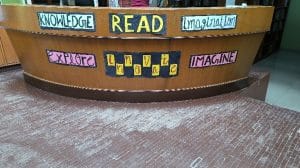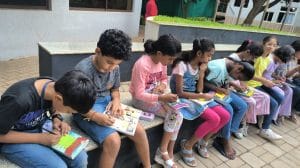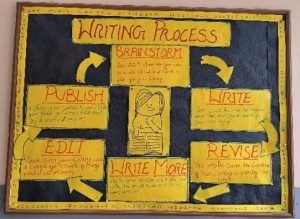My guiding principle has always been, “Learn to read, and then read to learn.” I am committed to fulfilling this objective, extending beyond mere activities. Are activities alone sufficient to achieve this goal, or do we need to provide additional motivation to ignite the passion for knowledge that comes through reading? As librarians, we must act as facilitators for our learners, guiding them on the path of learning and development through reading. Our role involves curating collections, recommending books, teaching information literacy, and maintaining a welcoming environment.
 Library Display as a Strategy
Library Display as a Strategy
We should adopt a marketing mindset, adhering to the adage “Jo dikhta hai woh bikta hai” (translated in English as What is seen is sold). Effectively advertising the library space is the first step in enticing learners to visit.
Genrefication
Organizing the library collection by genre is especially advantageous in a school setting, where young learners may not be familiar with specific authors but prefer books based on their mood. In my library, I have segregated books into genres like Mystery, Science Fiction, Folk Tales & Moral Stories, Thriller & Horror, Children’s Fiction, Behavioral-Self Help & Religious Books, Biography & Autobiography, Activity, Poetry, Lifestyle, Graphic Novels, and more. Readers who find books within their preferred genres are more likely to become engaged and enthusiastic about reading. For example, those who enjoy reading Enid Blyton’s Adventure books may also try similar authors like Franklin W. Dixon, Carolyn Keene, Roald Dahl, and E. Nesbit. This arrangement encourages them to explore and read other authors’ works as well.
Seating Arrangement 
Experimenting with seating arrangements in the library can make the reading experience more dynamic. We can change table and chair arrangements, take the students to open spaces for circle-time reading, have them sit on carpets, or do anything that complements the storytime. I often take them to the amphitheater, where they can sit, lie down, or even cross their legs and enjoy reading. This approach renders the library space more dynamic and inspiring. Establishing routines like shelving and organizing, checking books in and out, and setting behavior expectations are essential for the consistent and efficient functioning of the library. These can be introduced at the beginning of the session through library orientation.
Monthly Themes
Having monthly library themes and promoting displays present opportunities to engage learners in stories. I am sharing a few examples from my library themes: “The Book that Has Influenced Me Most,” “Authors from Our Country,” “Why I Like Graphic Novels,” “Explore Non-Fiction,” and so on.
Enticing Through Stories
Storytime isn’t limited to just reading; it can also involve listening or watching. Introducing a title and encouraging predictions and connections stimulates critical thinking and fosters curiosity about the book. Learning about the author’s life is equally inspiring, as it allows readers to connect with the author’s experiences, struggles, triumphs, perspectives, and background. Understanding an author’s life enhances the bond with their works and leaves a lasting impression. An author’s writing is a mirror of their life. I remember my childhood days of reading Premchand, Mahadevi Verma, Suryakant Tripathi Nirala, and Ramdhari Singh Dinkar. Reading their stories, I formed a deep bond with them, and the memories still resonate with me. In my library, learners enjoy reading authors like Roald Dahl, Ruskin Bond, J.K. Rowling, Liz Pichon, Michael Morpurgo, and Rick Riordan.
By exploring these ideas, a substantial portion of the motivation for reading is already established, and learners are inclined to delve deeper into the books. Discussing the theme enhances the reading experience by allowing learners to engage more fully with the central ideas or subject matter.
Reading & Learning 
Is learning solely achieved through reading? Yes, it certainly plays a significant role. Beginning with selecting the right book, encountering new words enriches vocabulary, while note-taking and summarization skills aid in comprehension. Reading fosters better communication skills, exercises the brain, and yields numerous learning outcomes. For example, my library heads a club called the Novelist Club, where students collaboratively write a novel, with each member contributing to the story. We emphasize that writing is most effective when supported by extensive reading. Other activities include representing classic novels through play adaptations, creating character wheels, and more.
 Read-Aloud Practice
Read-Aloud Practice
In my view, reading is more about learning. Our objective is to cultivate lifelong learners. Therefore, alongside promoting reading habits, sessions like note-taking and information literacy enhance the practice of reading. While we are all committed to promoting reading habits through various activities, it’s time to rejuvenate our efforts and start anew. As librarians, we strive to ensure that reading is enjoyable while simultaneously facilitating learning and intellectual growth for our young learners.
by Bhawna Sharma
Librarian
Treamis World School

